The United Nations Educational, Scientific and Cultural Organization (UNESCO) designated 2019 as the International Year of the Periodic Table (IYPT) to mark the 150th anniversary of the Mendeleev periodic table. This iconic resource, a vital tool for all who learn and work in science, provides ample opportunities to engage even the youngest students. You do not have to wait for the next anniversary to include a periodic table session in your science enrichment program.
| Time | Teams | Stations | Students | Age | Introduction | Time/Station | Conclusion |
|---|---|---|---|---|---|---|---|
| 60 minutes | 7 | 7 | ≤ 35 | All | 5 min | 7 min | 5 min |
| 75 minutes | 8 | 8 | ≤ 40 | All | 6 min | 8 min | 5 min |
| 90 minutes | 9 | 9 | ≤ 45 | 4th grade & up | 15 min | 8 min | 5 min |
The Stations
All the necessary printouts (decks of cards, tables, game boards, etc) for the stations described in this module can be downloaded using the button below:
Fusions & Fissions (Chutes and Ladders)
Supplies:
- Game Board: Print the three pieces of the Fusions & Fissions periodic table. Trim the center piece, then glue or tape the three pieces together to form the game board.
- Tokens/Markers: such as buttons, coins, pawns, squares of colored paper etc., one per player
- Two dice
The game is played as individuals. Assign each player a token, and place all on hydrogen. Players role the dice in turn, and advance that number of spaces in numerical order. If the token lands on an element with an arrow follow that arrow to the element indicated. The winner is the one farthest along when time is called.

Atomic Dice
Supplies:
- Game Board: Print the three pieces of the Atomic Dice periodic table. Trim the center piece, then glue or tape the three pieces together to form the game board.
- Markers: At least 100 pennies, buttons, counters, or pieces of colored paper.
- Two dice
The game is played as a team. Each turn, players roll both dice and then place a marker on ONE element, whose number is formed by combining, adding, subtracting, dividing, or multiplying the numbers on each die. For example, if you roll a two and a six you can choose one of the following:
#26 Fe (iron)
#62 Sm (samarium)
2 + 6 = #8 O (oxygen)
6 – 2 = #4 Be (beryllium)
6 / 2 = #3 Li (lithium)
6 x 2 = #12 Mg (magnesium)
If all possible elements for a given roll are already covered, roll again. The volunteer records the number of elements covered when time is called. At the end of the activity the winning team can be announced.
Go Fish
Supplies:
- Deck of “Go Fish” cards
Refer to the tool box for basic Go Fish rules. Children play the game as individuals. Children assemble “books” based on group such as “Halogens” or “Non-Metals”. In addition to the group name, the elements in each group have a matching card border. There are eight “Transition Metals” elements, so two “books” will be made from these. The winner is the child with the most “books” when time is called.
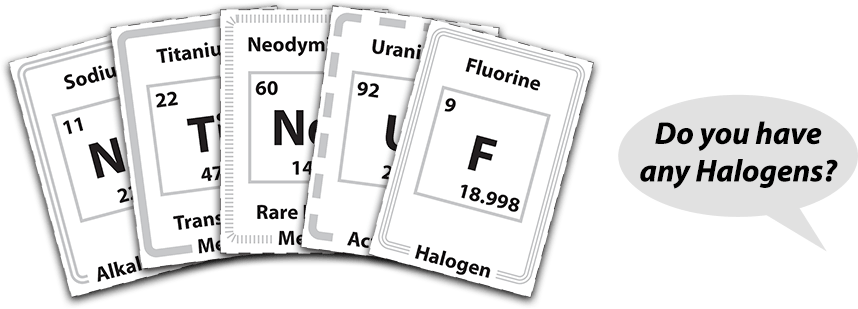
Element Memory
Supplies:
- Deck of “Memory” cards
- 1x Periodic table for each child
Prepare two 6 x 5 grids, with 15 elements for each. Refer to the tool box for basic memory game rules. Children match the element symbol with element name, and play as individuals. The second grid is for the next rotation to be sure it’s ready, or to use for a second round if older children finish the first too quickly.
Elemental Café
Supplies:
- Print a menu appropriate for the age of each child
- 1x Periodic table for each child
- Pencils
Start by having each child write his or her name on the menu. Explain how to decipher the menu by decoding the word Calcium Iron = Café on the first page of the menu. The children aren’t likely to finish in seven or eight minutes, so encourage them to take the menu home to complete there. If you’ll be meeting again soon you could challenge them to create new coded foods for the menu to share then.
Scavenger Hunt
Supplies:
- Print one copy of each of the four topical periodic tables: discovery, uses, how formed, and standard black and white. If possible, put them into sheet protectors.
- Age-appropriate scavenger hunt sheets.
- Pencils
The children play as a team. Write the “team” name on the sheet. One child is the scribe, writing the answers as the other children find the answers using the periodic tables. The volunteer retains the sheet when time is called, and records the number of questions answered. At the end of the activity announce the best team score (or scores if both age levels were involved).
ATOMS (BINGO)
Supplies:
- Deck of ATOMS cards
- ATOMS tokens
- Bingo markers, pennies, buttons, etc.
Refer to the toolbox for basic bingo rules. The children play individually. The caller draws and reads an atomic symbol at random, while children mark the appropriate element names on their cards. The “ATOMS” square is free.

Element-O
Supplies:
- Deck of Element-O cards
- 1x Card rack per player
Refer to the Sequence Matching Game rules in the toolbox. A template for easy homemade cardboard racks is included in the downloadable files for this module. If you have more than 6 students playing, have them organize in teams of two. Use the following numbers of cards depending on the number of students/teams playing:
| # of Players | Cards to Use |
|---|---|
| 2 | 1 to 40 |
| 3 | 1 to 50 |
| 4 | 1 to 60 |
| 5 | 1 to 70 |
| 6 | 1 to 80 |
Elemental Lotto
Supplies:
- Deck of “Lotto” cards (The Go Fish deck + the Mendeleev card)
- 1x Lotto board per player
Lotto is played essentially the same as Bingo, except players have a board with pictures of the cards (or Mendeleev). Children play the game as individuals.
BONUS: Giant Periodic Table
Supplies:
- Crayons, colored pencils, or markers
- Glue or glue sticks
- 1x Blank element card per student (+ a few extra)
- 1x Instructions per student
- Prepare a blank periodic table scaled for the element cards on butcher or similar paper. Schools often have large rolls of wide colored paper. You may choose to prepare an abbreviated table, perhaps just those elements known to Mendeleev.
- 2-3x Periodic tables, in words. You can place the halves in sheet protectors, or trim the right-hand portions and glue/tape the left-hand portions
Let children choose an element, or assign one. Consider writing an element symbol on the back of each blank in pencil so choosing doesn’t take too long. Each child fills out the information needed and decorates the blank as time permits. The volunteer attaches finished blanks to the periodic table grid. Students can admire their handiwork at the end of the activity.
Although we’ve shuffled this station out of the main rotation, you can certainly swap it in if that suits your fancy. An alternative approach is to have children do this as a “take-home” activity: Give them each a blank card and an element; they each complete their card at home and bring them back the next session for assembling the table. Be sure to have some extra blanks on hand, though, for the inevitable lost or forgotten cards.
Preparation
Choose the games for your stations, and assemble supplies for each according to the games’ rules. Prepare the first and second grade versions as well if needed.
Prepare name tags. Choose the pre-made seven, eight, or nine station tags, or, if you’ve chosen different games, complete the appropriate blank tags. Print four or five copies depending on how many children are on each team. Assign children to teams. If your group includes first and second graders, compose teams exclusively of those younger students.

With so many stations it is particularly important that teams don’t get confused during the rotations. Prepare a sign for each station with game name and number according to your name tags. It is amazing how hard it can be to keep all teams headed in the right direction, especially after several rotations have passed.
Teach volunteers the rules of their games. Give those keeping track of scores (Atomic Dice and Scavenger Hunt) scratch paper and a pencil. Ask each volunteer to check name tags at each rotation before beginning play to make sure the children are at the correct station.
You will need a countdown timer, and perhaps a whistle, bell, or similar item since children may be noisy playing the games.
Running the Activity
Introduction
Your introduction depends on the time you have, the age of your students, and their science background.
If possible, have a larger version of the periodic table to show, and a drawing of a simple atom showing electrons, protons, and neutrons. With younger students just touch on the following points:
- An element is a pure substance which cannot be broken down by chemical means. The number of protons in the nucleus is the defining property of an element, and is referred to as the atomic number.
- Dmitri Mendeleev was a Russian chemist and inventor. He formulated the Periodic Law and created the first version of the periodic table of the elements in the 1860s. He used the Periodic Law to correct the then-accepted properties of some known elements and predict the properties of eight elements that were not yet discovered.
- The periodic table is a table of the chemical elements arranged by atomic number, electron configuration, and recurring chemical properties. The structure of the table shows periodic trends. The seven rows of the table, called periods, generally have metals on the left and nonmetals on the right. The columns, called groups, contain elements with similar chemical behaviors.
With older students and more time discuss the nature of elements in the various groups, that many of the heaviest elements are man-made and last only a fraction of a second, the fact that the periodic law predicted elements not discovered for over a hundred years and other topics as time permits.
Have children find the element on their name tags, which is their team name, and find their teammates. Point out the rotation order on those tags, and explain that they’ll go from station to station in numerical order. Send teams to the first game on their tag. When all have arrived at their appointed stations start the timer. Announce when time is up, instruct teams to move, giving the rotation number, and promptly restart the timer.
Conclusion
Gather the children. Announce the winning teams for Atomic Dice and the Scavenger Hunt. Encourage children to finish the Elemental Café menu at home, and to try to create more items for it. Display the large periodic table if you made one.
How did your elemental explorers do? Have any ideas for more periodic table activities? We’d love to hear it! Drop us a note or leave a comment!


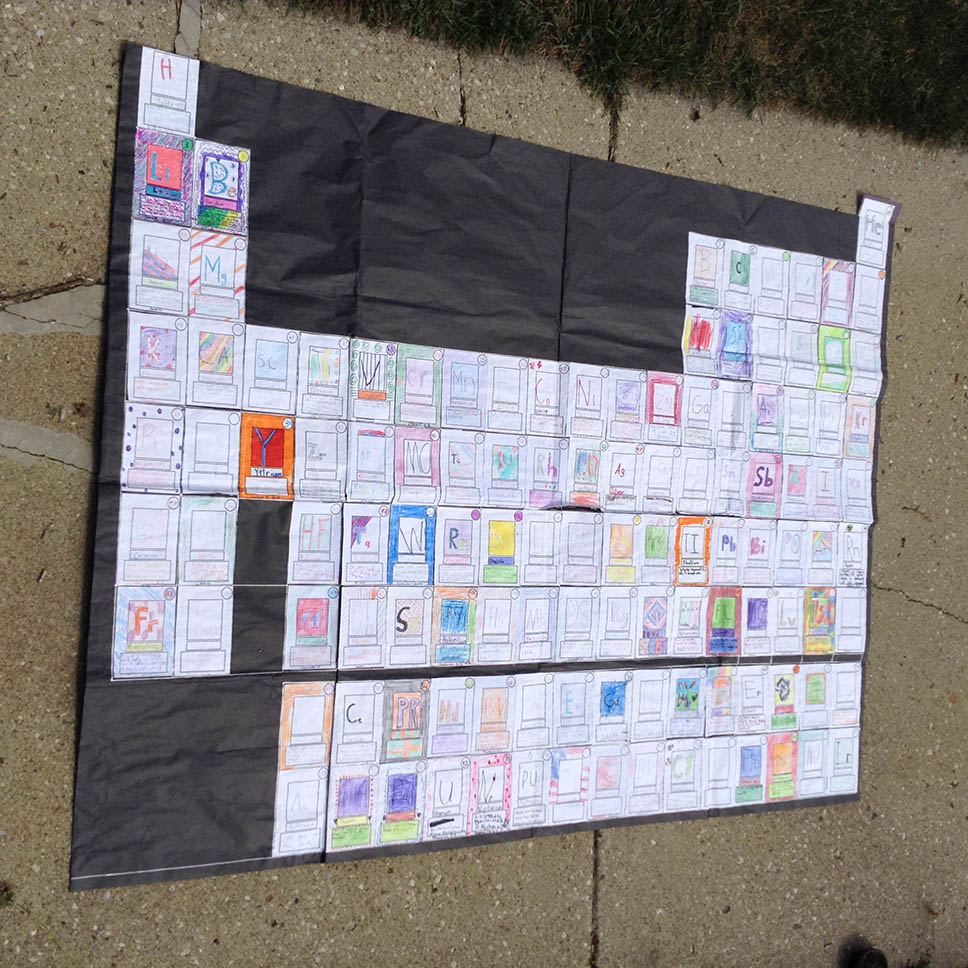
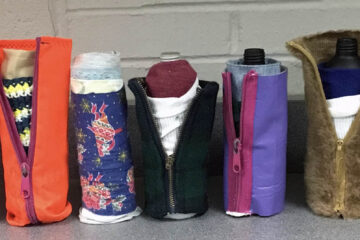
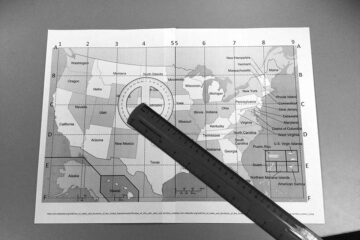
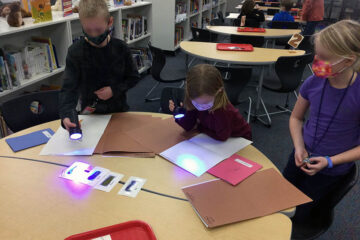
0 Comments